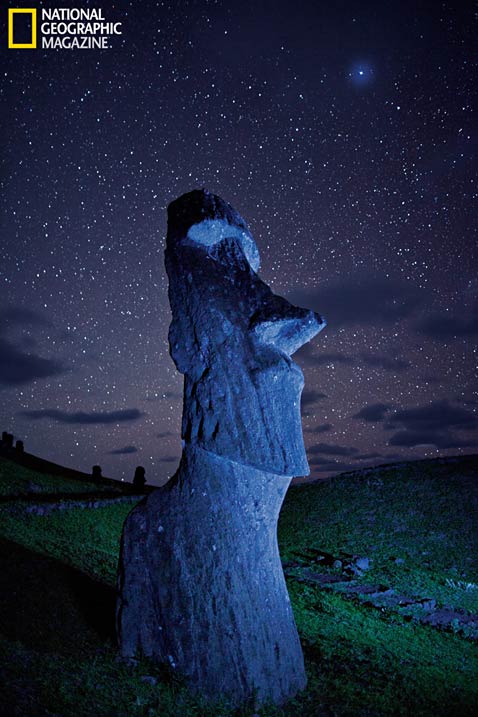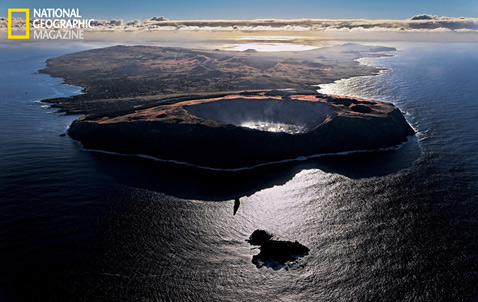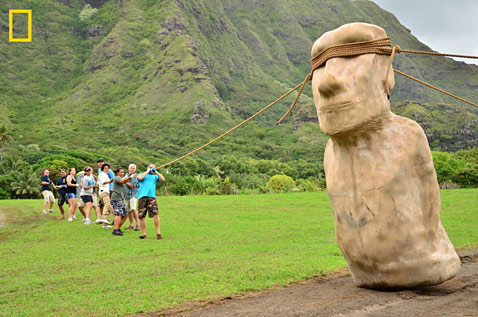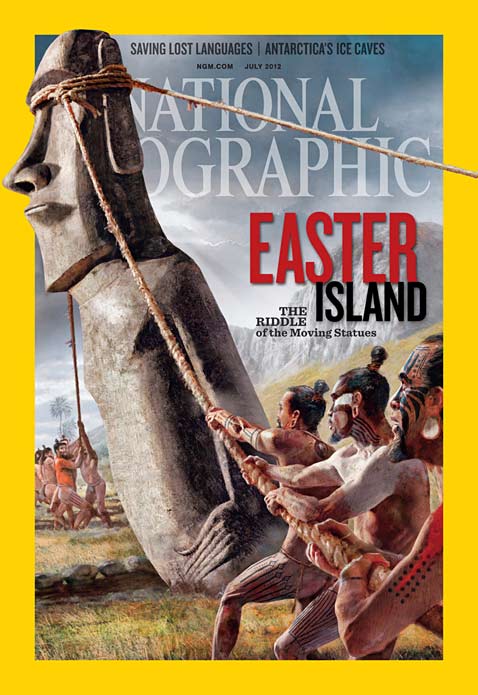The Riddle of The Statues of Easter Island, Solved?
Archeologists Terry Hunt of the University of Hawaii and Carl Lipo of California State University Long Beach, have studied Easter Island for the past decade and reveal their latest theory of how the island's iconic statues were carved with stone tools, mostly in a single quarry, then transported without draft animals or wheels to massive stone platforms, or ahu , up to 11 miles away.
The following are photos and excerpts from the July 2012 issue of National Geographic.

"The statues walked," Easter Islanders say. Archaeologists are still trying to figure out how and whether their story is a cautionary tale of environmental disaster or a celebration of human ingenuity. (Randy Olson/National Geographic)
Easter Island covers just 63 square miles. It lies 2,150 miles west of South America and 1,300 miles east of Pitcairn Island, its nearest inhabited neighbor. After it was settled, estimates put it at roughly 1000 years ago, it remained isolated for centuries. All the energy and resources that went into the statues, or moai-which range in height from four to 33 feet and weight more than 80 tons - came from the island itself.

Three volcanoes, quiet now, formed Easter Island half a million years ago. It has three crater lakes but no streams; fresh water is scarce. Chile, the island's source of fuel and most food, is 2,150 miles away. (Randy Olson/National Geographic)
Last year, in experiments funded by National Geographic's Expeditions Council, Hunt and Lipo showed that as few as 18 people could, with three strong ropes and a bit of practice, easily maneuver a 10-foot, 5-ton moai replica a few hundred yards. In real life, walking miles with much larger moai would have been a tense business. Dozens of fallen statues line the roads leading away from the quarry. But many more made it to their platforms intact.

Archaeologists Carl Lipo of the University of California State University Long Beach, left, and Terry Hunt of the University of Hawaii stand in front of a full-scale replica of a stone statue from Easter Island known as a moai. (Marc Kelly/National Geographic)

As a team of volunteers pulls in one direction and a group across from them coordinates, a full-scale replica of an Easter Island moai "walks" down a road in Hawaii, where the experiment was conducted. The experiment, which involved two groups rocking the statue from side to side while a third stabilized it from behind, showed that a minimum of 18 people could move the 10-foot, 5-ton moai a few hundred yards without it tipping over. (Sheela Sharma/National Geographic)

Their backs to the Pacific, 15 restored moai stand watch at Ahu Tongariki, the largest of Easter Island's ceremonial stone platforms. Rapanui artisans carved the moai centuries ago from volcanic rock at a quarry a mile away. By the 19th century all of Easter's moai had been toppled-by whom or what is unclear. In 1960 these moai were swept inland by a tsunami, which fractured some, left. (Randy Olson/National Geographic)

(National Geographic)
See more photos in the July edition of National Geographic magazine.